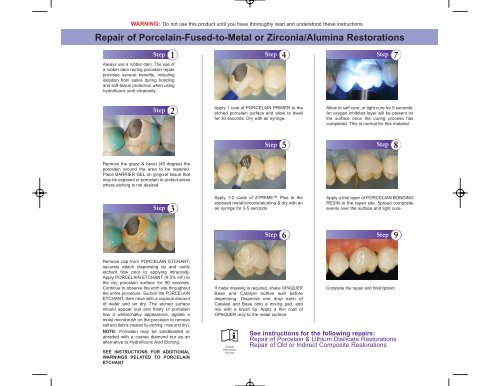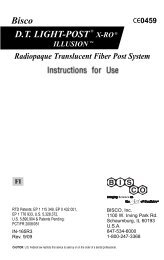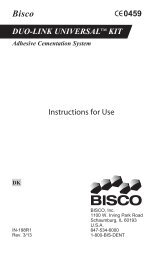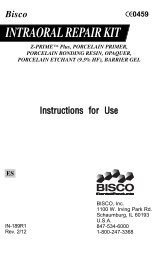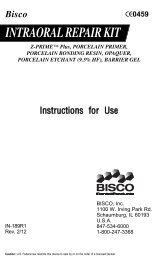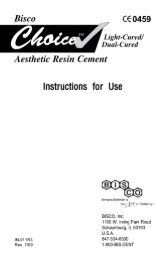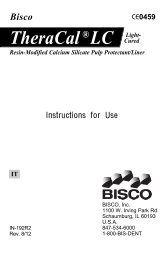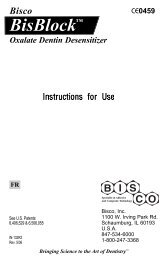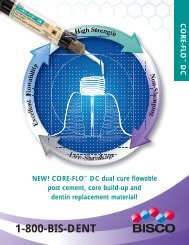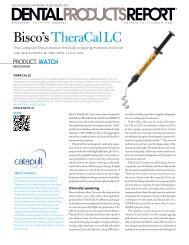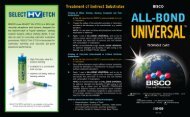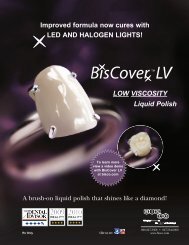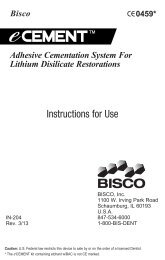intraoral repair kit technique card - Bisco, Inc.
intraoral repair kit technique card - Bisco, Inc.
intraoral repair kit technique card - Bisco, Inc.
You also want an ePaper? Increase the reach of your titles
YUMPU automatically turns print PDFs into web optimized ePapers that Google loves.
WARNING: Do not use this product until you have thoroughly read and understood these instructions.Repair of Porcelain-Fused-to-Metal or Zirconia/Alumina RestorationsStep1Always use a rubber dam. The use ofa rubber dam during porcelain <strong>repair</strong>provides several benefits, includingisolation from saliva during bondingand soft-tissue protection when usinghydrofluoric acid <strong>intraoral</strong>ly.Step4Step7Step2Apply 1 coat of PORCELAIN PRIMER to theetched porcelain surface and allow to dwellfor 30 seconds. Dry with air syringe.Allow to self cure, or light cure for 5 seconds.An oxygen inhibited layer will be present onthe surface once the curing process hascompleted. This is normal for this material.Step5Step8Remove the glaze & bevel (45 degree) theporcelain around the area to be <strong>repair</strong>ed.Place BARRIER GEL on gingival tissue thatmay be exposed or porcelain to protect areaswhere etching is not desired.Step3Apply 1-2 coats of Z-PRIME Plus to theexposed metal/zirconia/alumina & dry with anair syringe for 3-5 seconds.Apply a thin layer of PORCELAIN BONDINGRESIN to the <strong>repair</strong> site. Spread compositeevenly over the surface and light cure.Step6Step9Remove cap from PORCELAIN ETCHANT,securely attach dispensing tip and verifyetchant flow prior to applying <strong>intraoral</strong>ly.Apply PORCELAIN ETCHANT (9.5% HF) tothe dry porcelain surface for 90 seconds.Continue to observe the etch site throughoutthe entire procedure. Suction the PORCELAINETCHANT, then rinse with a copious amountof water and air dry. The etched surfaceshould appear dull and frosty (if porcelainhas a white/chalky appearance, agitate amoist microbrush on the porcelain to removesalt and debris created by etching, rinse and dry).NOTE: Porcelain may be sandblasted orabraded with a coarse diamond bur as analternative to Hydroflouric Acid Etching.SEE INSTRUCTIONS FOR ADDITIONALWARNINGS RELATED TO PORCELAINETCHANTIf metal masking is required, shake OPAQUERBase and Catalyst bottles well beforedispensing. Dispense one drop each ofCatalyst and Base onto a mixing pad, andmix with a brush tip. Apply a thin coat ofOPAQUER only to the metal surface.ConsultInstructionsFor UseComplete the <strong>repair</strong> and finish/polish.See instructions for the following <strong>repair</strong>s:Repair of Porcelain & Lithium Disilicate RestorationsRepair of Old or Indirect Composite Restorations


